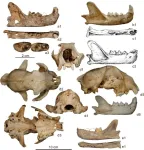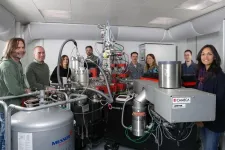(Press-News.org) Researchers have demonstrated new wearable technologies that both generate electricity from human movement and improve the comfort of the technology for the people wearing them. The work stems from an advanced understanding of materials that increase comfort in textiles and produce electricity when they rub against another surface.
At issue are molecules called amphiphiles, which are often used in consumer products to reduce friction against human skin. For example, amphiphiles are often incorporated into diapers to prevent chafing.
“We set out to develop a model that would give us a detailed fundamental understanding of how different amphiphiles affect the surface friction of different materials,” says Lilian Hsiao, corresponding author of a paper on the work and an associate professor of chemical and biomolecular engineering at North Carolina State University. “The model helps us understand the molecular basis for friction reduction and can be used by engineers to tailor a material’s properties for different applications.”
“We then began a series of experiments to explore whether we could use amphiphiles to modify materials and incorporate them into haptic energy harvesters,” says Saad Khan, co-corresponding author and INVISTA Professor of Chemical and Biomolecular Engineering at NC State. “Specifically, we wanted to know if we could create energy from friction in amphiphile-modified materials. It turns out we could not only generate electricity, but we could do so while also reducing the friction that people wearing these materials experience.”
In other words, the researchers found they could use amphiphiles to create wearable fabrics with slippery surfaces that feel good against human skin.
The researchers also found that some amphiphiles have electronic properties that allow them to “donate” electrons. And when the researchers incorporated those electron-donating amphiphiles into the wearable materials, the end result was a material that was both comfortable and capable of generating electricity through friction produced by rubbing against human skin or other materials.
“The technology for harvesting static energy is well established but devices that can be worn for long periods of time are still missing.” Hsiao says. “In our proof-of-concept testing, we found these amphiphile materials not only feel good on the skin but could generate up to 300 volts, which is remarkable for a small piece of material.”
“An optimal balance between friction needed to generate power and maintaining the comfort of the wearer is paramount in designing haptic technologies and amphiphile chemistry offers a facile way to do so,” Khan says. “We’re interested in doing more to make use of these materials, such as exploring how they can be incorporated into existing haptic devices. And we’re open to working with industry partners on identifying new applications.”
The paper, “Compressing Slippery Surface-Assembled Amphiphiles for Tunable Haptic Energy Harvesters,” will be published Sept. 15 in the journal Science Advances. First author of the paper is Pallav Jani, a Ph.D. graduate of NC State. The paper was co-authored by Kushal Yadav, another Ph.D. student at NC State, Maryanne Derkaloustian and Charles Dhong of the University of Delaware, and by Hilmar Koerner, who leads the Polymer Matrix Composites Program at the Air Force Research Laboratory.
This work was done with support from the Nonwovens Institute under project 18-224SB; the National Science Foundation under CAREER award number 2042635; the AFRL under the Summer Faculty Fellowship Program; the Sloan Research Fellowship under grant number FG-2022-18336; the Dreyfus Foundation, under grant number TC-22-038; the National Institutes of Health under grant R01EY032584-02; and the National Eye Institute under grant 5R01EY032584-03.
END
Researchers make comfortable materials that generate power when worn
2025-01-15
ELSE PRESS RELEASES FROM THIS DATE:
Study finding Xenon gas could protect against Alzheimer’s disease leads to start of clinical trial
2025-01-15
Most treatments being pursued today to protect against Alzheimer’s disease focus on amyloid plaques and tau tangles that accumulate in the brain, but new research from Mass General Brigham and Washington University School of Medicine in St. Louis points to a novel—and noble—approach: using Xenon gas. The study found that Xenon gas inhalation suppressed neuroinflammation, reduced brain atrophy, and increased protective neuronal states in mouse models of Alzheimer’s disease. Results are published in Science Translational Medicine, and a phase 1 clinical trial of the treatment in healthy volunteers will begin in early 2025.
“It ...
Protein protects biological nitrogen fixation from oxidative stress
2025-01-15
A small helper for big tasks: an oxygen sensor protein protects the enzymatic machinery of biological nitrogen fixation from serious damage. Its use in biotechnology could help to reduce the use of synthetic fertiliser in agriculture in the future. A research team led by biochemist Prof. Dr Oliver Einsle from the Faculty of Chemistry and Pharmacy and the Centre for Biological Signalling Studies (BIOSS) at the University of Freiburg has discovered exactly how the so-called Shethna protein II works. The scientists used the newly established cryo-electron microscopy in Freiburg. ...
Three-quarters of medical facilities in Mariupol sustained damage during Russia’s siege of 2022
2025-01-15
Three-quarters of medical facilities in Mariupol sustained damage during Russia’s siege of 2022, with some evidence that the attacks may have been intentionally targeted, per study using satellite imagery.
####
Article URL: https://journals.plos.org/globalpublichealth/article?id=10.1371/journal.pgph.0003950
Article Title: The effect of conflict on damage to medical facilities in Mariupol, Ukraine: a quasi-experimental study
Author Countries: Germany, United States
Funding: This work was supported ...
Snow leopard fossils clarify evolutionary history of species
2025-01-15
The snow leopard (Panthera uncia) is a large feline unique to the Qinghai-Tibet Plateau and its surrounding areas. As the apex predator in the region, the snow leopard plays a crucial role in maintaining ecological stability. Its unique characteristics, coupled with its striking appearance, have made it a flagship species for conservation efforts aimed at protecting the ecosystem of the Qinghai-Tibet Plateau.
Unfortunately, few snow leopard fossils have been found in the Qinghai-Tibet Plateau region, particularly fossils from the Quaternary period. As a result, it’s unclear how snow leopards evolved their specialized adaptations to this environment.
On the one hand, molecular ...
Machine learning outperforms traditional statistical methods in addressing missing data in electronic health records
2025-01-15
Researchers from the National Institute of Health Data Science at Peking University and the Department of Clinical Epidemiology and Biostatistics at Peking University People's Hospital have conducted a comprehensive systematic review evaluating strategies for addressing missing data in electronic health records (EHRs). Published in Health Data Science, the study highlights the growing importance of machine learning methods over traditional statistical approaches in managing missing data scenarios effectively.
Electronic health records have become a cornerstone in modern healthcare research, enabling analysis across clinical trials, treatment effectiveness studies, and ...
AI–guided lung ultrasound by nonexperts
2025-01-15
About The Study: In this multicenter validation study, trained health care professionals with artificial intelligence (AI) assistance achieved lung ultrasound images meeting diagnostic standards compared with lung ultrasound experts without AI. This technology could extend access to lung ultrasound to underserved areas lacking expert personnel.
Corresponding Author: To contact the corresponding author, Cristiana Baloescu, MD, MPH, email cristiana.baloescu@yale.edu.
To access the embargoed ...
Prevalence of and inequities in poor mental health across 3 US surveys
2025-01-15
About The Study: This survey study documents increasingly prevalent poor mental health from 2011 to 2022 across multiple U.S. health surveys, with notable prevalence differences in Behavioral Risk Factor Surveillance System and National Survey on Drug Use and Health vs National Health Interview Survey. Inequities in these outcomes by age, sex, and racial and ethnic group were often sizeable and changed over time in distinct ways, consistent with findings in prior literature.
Corresponding Author: To contact the corresponding ...
Association between surgeon stress and major surgical complications
2025-01-15
About The Study: In this cohort study including 38 attending surgeons and 793 patients, increased surgeon stress at the beginning of a procedure was associated with improved clinical patient outcomes. The results are illustrative of the complex relationship between physiological stress and performance, identify a novel association between measurable surgeon human factors and patient outcomes, and may highlight opportunities to improve patient care.
Corresponding Author: To contact the corresponding author, Jake Awtry, MD, email jawtry@bwh.harvard.edu.
To access the embargoed study: Visit our For The Media ...
How cryogenic microscopy could help strengthen food security
2025-01-15
According to the United Nations, soil salinization affects between 20% and 40% of arable land globally, with human activity and climate change – especially rising sea levels – largely responsible for this process. While the human body needs sodium to function, this is not the case for most plants. In fact, excess salt around plants’ roots gradually blocks their access to water, stunting their growth, poisoning them and hastening their death. Ten million hectares of farmland are destroyed by soil salinization every year, posing a threat to global food security.
Scientists at EPFL, ...
DNA damage can last unrepaired for years, changing our view of mutations
2025-01-15
While most known types of DNA damage are fixed by our cells’ in-house DNA repair mechanisms, some forms of DNA damage evade repair and can persist for many years, new research shows. This means that the damage has multiple chances to generate harmful mutations, which can lead to cancer.
Scientists from the Wellcome Sanger Institute and their collaborators analysed family trees of hundreds of single cells from several individuals. The team pieced together these family trees from patterns of shared mutations between the cells, indicating common ancestors.
Researchers uncovered unexpected ...



